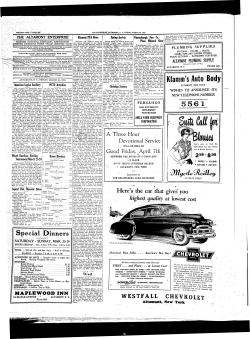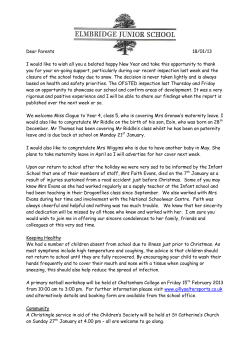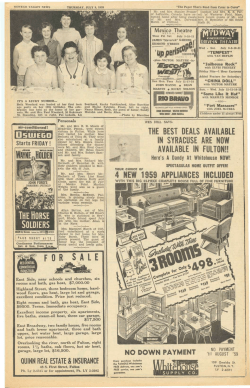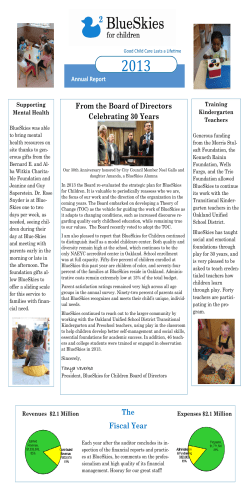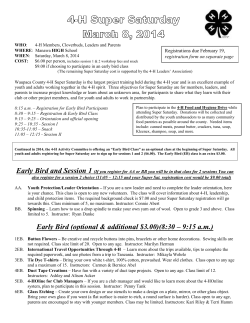
How To Effectively Promote Continued Summer Study At Your Center
July 2007 June How To Effectively Promote Continued Summer Study At Your Center Mr. Miyake’s Seminars Mrs. Kishibe In Mexico Student Data Verification How to Avoid a Late Fee Elite Retreat in Jamaica was “Irie” Dunn’s River Falls - Ocho Rios, Jamaica How To Effectively Promote Continued Summer Study At Your Center by Daniel Wooster With the summer months upon us, more than good weather and the smell of barbeque are in the air. It is during this time of year that two dreaded sentences come out of yearly slumber to torment us - “I am going on vacation” and “I am looking to enroll for the summer only.” These two sentences are the equivalent of fingernails scraping down a chalkboard for Kumon Instructors who recognize that the true value of the program comes from year-round, long-term study. However, the reality of the situation is that we, as Kumon Instructors, work diligently with these students to help them reach their full potential, even during a short, three-month timeframe, whether they are in the Center or sharing their time with Mickey and Minnie Mouse. This reality causes Kumon Instructors to ask the question: after summer retention, what next? How do I get the students on vacation to return to my Center, and how do I take the ones who just “came for the summer” and turn them into ones who “come for the fall, winter and spring, too?” The opportunity lies in developing a comprehensive communications program that motivates your students and invites their parents to vacation in the world of their child’s continued success. The best tool you have is being able to show Kumon parents the improvements the program is making currently and what success their child can experience three, six, nine and 12 months down the road under your guidance. For parents who just want to enroll for the summer months, Margaret Case, Florida Branch, shows progress charts of her successful full-time students (with the names blanked out) who have started below grade level and taken a year to catch up. “I use parents that I know will say positive things about the program and who are still enrolled,” she says. “For students that really are fairly high performers, I show sixmonth projections, always stressing subject to actual performance, which was impossible to know at enrollment,” she continues. “Stress Kumon’s individualized program. Parents seem to respond to this. They still may think their kid is the exception, but one thing is certain – if you don’t even get them in the door, you don’t stand a chance of keeping them long-term.” Kumon has compiled a list of different initiatives that Instructors can utilize over the summer months to promote continued involvement in the program. Whether the family is planning on a vacation sans worksheets or determined to enroll for the summer months only, you will find helpful tools and tips below to help you tackle this problem 1 effectively, efficiently and proactively. 1) Goal Setting Conferences: One of the most important initiatives to help keep families from leaving Kumon during the summer months and to promote the continued tenure of short-term students is to hold one-on-one meetings or conferences with your students and their parents to discuss individual goals. • Vacationing Students: Hold goal-setting conferences prior to their vacation to discuss the tangible and attainable goals that can be achieved through continued study over the summer months with both your students and their parents. If they do choose to take a break from Kumon, plan a back-to-school goal-setting conference to promote the benefits of Kumon study during the school year. Utilizing the Summer Planning calendar is highly beneficial in proactively planning these sessions. • Short-Term Students: Utilize the goal-setting conference tool upon their enrollment to offer an understanding of the growth they can experience during their brief involvement in the Kumon program. This is a great time for you to discuss the benefits of long-term study and plant the seed of continued participation after the summer months. 2) Goal vs. Actual Meetings (Short-Term Students): At close to the end of the student’s tenure in the Kumon program, utilize the Goal vs. Actual Graph found on CMS2. With this tool, you can demonstrate the successes the student has experienced over the summer and the growth they can accomplish through: a) Continued study b) Reaching grade level and beyond. Having the student re-take the Placement Test is a wonderful way to tangibly show the growth they have achieved over such a short timeframe. 3) Center Newsletters: Your Center newsletter is a well-read communications vehicle that you can utilize proactively to promote the benefits of continued study over the summer months and the benefits associated with returning to or continuing the Kumon program during the school year. 4) Summer Planning Calendars: Your Summer Planning calendar, which you should have received with your monthly shipment, is a wonderful tracking and communications tool. Utilizing the calendar allows you to record and track when and for how long your students are on vacation and, most importantly, when they return. This information allows you to proactively prepare to communicate with your families about returning to or continuing The Bridge • July 2007 How to Avoid a Late Fee For U.S. Instructors: Your monthly Report B must be complete, accurate and on time in order to avoid the $200 late fee. You will be charged the $200 Late Report Fee if you fail to submit a complete and accurate report by 11:59 p.m. local time where your Center is located for any of the following: Instructor B Reports, Student Application Forms, Placement Tests, and Achievement Tests (Chapter 5, Section III of the Operations Manual). You must accurately report level attainment and worksheets used for every current student, including full exempt students (Instructor’s own children). with the Kumon program. Some communications vehicles you can utilize are as follows. • Send a post card to your families wishing them a wonderful vacation - This will help keep you top-of-mind for families who have taken a break over the summer months. • Telephone calls or e-mails welcoming families back from vacation and asking to set-up an appointment - This helps bring the family back to your Center. Now is a good time to use the goal-setting conferences. • Thank You Letters (Short-Term Students) - This tool allows you to thank the student and parents for their time and efforts in the program and invites them to join you to discuss the growth and successes of their child. This is a good time to use the goal-setting conferences. 5) A Great School Year Begins in the Summer/Fall Brochures: The most important aspect of keeping students over the summer, having them return after their vacation, or continue after a shortterm commitment, is the open and timely communication of the benefits they can expect. Utilize the brochure A Great School Year Begins in the Summer to promote the benefits of continued study over the summer. For those families who decide to take a break from Kumon or are only interested in summer study, use the A Great School Year Begins in the Fall brochure to promote the benefits of Kumon study during the school year. In the April edition of The Bridge, we shared the different summer retention activities utilized by Instructors in Canada and the United States. I invite you to revisit this information as there were many wonderful tools and tips you can use in conjunction with the concepts mentioned above to truly bolster your summer retention. If you have any questions or need to discuss your summer plans, please do not hesitate to contact your local branch. They have many ideas, materials and expertise to help you develop and/or put in place initiatives that can make a difference. Please contact them for further advice or assistance. While we cannot keep parents from proverbially running their fingernails down the chalk board through discussions of vacation and summer study, we can now proactively and effectively tackle this matter. By actively sharing the long-term benefits of the Kumon program and offering timely information regarding each student’s growth and success, we can educate parents about the benefits of continued study and help them take a vacation in the success of their child and tan under the radiance of their new-found confidence. ••• News from MDD The Math Team of the Materials Development Department is pleased to announce that the official version of the Level X worksheets is ready to be released. Level X is the elective course which students can solve after completing the Math Program. It includes the topics of triangles, vectors, matrices, mapping and transformation, probability and statistics. You will be receiving a sample box, which will include a copy of the worksheets, the solution books, and an updated version of the formula book (among other items). Please be sure to review carefully the instruction notes and the reporting guidelines of the new level. For instructional information regarding Level X, please refer to the article written in the latest issue of Voices. If you have any questions about the new materials or would like to discuss lesson planning suggestions for your students, please contact MDD at [email protected]. New Operations Manual (U.S. version) Is On iKumon We are pleased to announce that the 2007 Kumon Operations Manual is now available on iKumon. This online version is easy to navigate and contains features that make it simple to access the information you’re looking for, including helpful links to forms, tools, references, and websites. You are also able to print out printer-friendly versions of individual chapters should you prefer hardcopies of the document. The Operations Manual is a very important source of reference for Kumon franchisees as many sections of the Franchise Agreement reference the Operations Manual for further explanation of Kumon’s most current policies and regulations. In fact, Section 9 of the Franchise Agreement indicates that “You must adhere to all standards, rules, and regulations contained in the Operations Manual.” Therefore, it should be referred to regularly to ensure proper Kumon Center operations. Log on to iKumon and check out the new and enhanced Kumon Operations Manual. The Canadian version of the OM is in the final stages of production and should be online shortly. 2 Mr. Miyake’s Seminars Encourage Instructors t During a Professional Development seminar in Houston, Mr. Miyake gave two presentations on the SCT and Learning from Excellent Students. Recently, I had the great pleasure of attending Mr. Miyake’s Professional Development seminar in Houston, Texas, from May 10th through 11th. Over the course of these two days, 35 Instructors (including seven from the Washington, D.C. Branch) and several Kumon Field Associates learned how to better observe students and, in turn, to apply lessons learned from excellent students to all students. Training began with the following words from Mike Shim of the Instruction Department, “I encourage you to have an open mind.” After such an evocative sentence, I began to wonder “What are going to learn here?” Mr. Miyake began by presenting an updated version of Individualized Application of the Standard Application of the Standard Completion Time, first introduced at the Maui Elite Retreat in 2006. Before arriving at the central focus of his presentation, Mr. Miyake provided a brief history of the SCT. Did you know that the SCT was first implemented 15 years after the introduction of the Kumon Method? Needless to say, I was surprised to hear this! By observing the traits of successful students in the early years of Kumon, it was shown that these students displayed strong mental calculation ability. The SCT was created, therefore, as a standard to benefit all students. At this point, I realized that Learning from Excellent Students is not a new concept but rather has been integral in the development of the Kumon Method for many, many years. Mr. Miyake further stressed the importance of assessing ability and the study condition of each child at a given time. The job of the Instructor is to use SCT as one measure to assess ability and to maximize each student’s full potential. To this aim, while the decision to let children repeat or advance based on SCT will be correct for 90 percent of students, it may not be correct for the other 10 percent due to personality and intelligence. Therefore, Mr. Miyake suggests bold instruction for this 10 percent of students who possess high ability by not applying the SCT. Specific examples of a student’s ability not being reflected in SCT are: pre-schoolers 3 in 3A who have the ability to add quickly but are hampered by still-developing motor skills, students who mentally recheck their answers (thus adding to their SCT), and students who are slow at the beginning of a set but then quickly complete the finishing worksheets. I’ll particularly remember the following quote from Mr. Miyake, “Use the standard. Don’t be used by the standard.” Aided by progress history charts, completed worksheets, student videos and information pertaining to each student, we looked at the study history of several students who have benefited from this bold form of instruction. In this exercise, we took special care to notice when and how these students expressed their high ability. With this information, we realized that, oftentimes, we notice a student’s struggles but not where they succeed, particularly in difficult sets. Such a hands-on approach and the ability to discuss observations in a group environment led to a lively learning environment. I learned so much in listening to the observations of my group members. Mr. Miyake’s second presentation, Learning from Excellent Students and Observation of Students, was a great way of unifying the theory of progressing students with high-ability through bold instruction to the importance of observing students. First, Mr. Miyake encouraged us all to put aside our preconceptions (i.e. only exceptional children can exceed school grade level by two or more years and preschoolers aren’t capable of reaching equations) and reassured us. For at first, Chairman Toru Kumon himself didn’t believe it was possible for preschoolers to complete equations until students proved otherwise. To achieve our vision individually and collectively, it is important to “apply what we learn from advanced students, what we learn from the parents of advanced students, and what we learn from Instructors of advanced students to the instruction of other students.” Additionally, imitating the good habits of advanced students has been shown to be an effective way of helping weaker students, e.g. limiting the use of carrying and borrowing. To this end, Mr. Miyake reinforced the importance of observation The Bridge • July 2007 to Have an Open Mind By Brian Rottkamp Student Data Verification Students cannot be fairly recognized and awarded for their achievements if valuable information is inaccurate or missing! The student information you provide each month on your Report B is used to produce your Instructor Achievement Summaries, CMF-A, and fulfillment of student achievement. To ensure the information we have is correct, we need your help to verify dates of birth and provide any missing information for dates of birth, school grades and Kumon level attainment on your Report B. Please use the chart below as a guideline when confirming school grades and birth dates. Instructors and Associates discuss a case study during a breakout session. as a way of “learning from children” and of having improved instructional ability. He encouraged Instructors to gain experience by instructing as many students as possible and to gain the experience of fostering students who rank high on the ASHR. Mr. Miyake provided six ways to better understand each student. 1) Dialogue with the student: From this we can learn of a student’s goals, language skills, and personality. 2) Observation from a distance: We can observe a student’s attitude when doing the worksheets, concentration level, persistence, and speed. 3) Closely observing students’ worksheets as they solve them: We can observe a student’s skill at mental calculation, reasoning ability, attentiveness, error correction ability, carefulness of writing, and where “does the pencil stop.” 4) Examination of completed worksheets: We can observe a student’s mental calculation and how intermediate steps are approached. 5) Examination of the score card: We can observe a student’s completion time on the first attempt, the effectiveness of repetition, and orderliness of the student’s Kumon study. 6) Talk to parents: We can learn of a student’s goals, the amount of reading done at home, favorite books, dreams, and favorite activities. In closing, Mr. Miyake quoted Chairman Toru Kumon in saying, “With the Kumon Method, Instructors improve their instructional skills by learning from their students.” I feel quite blessed to have been able to experience this amazing opportunity and to gain concrete information on how we can continue to learn from our students. Additionally, I would like to recognize in a special way the Washington, D.C. Instructors I previously mentioned: Joanne Chun, Lily Chen, Olivia Cho, Chris Ham, Gonette Caparros, Youngmi Lee, and Kimiko Kotani. I consider myself honored to have shared this learning experience with all of you! ••• Thank you in advance for ensuring our system has the most up-todate information for your students. Year of Birth School Grade* Approximate Age** 1989 & older 13 18 – older 1990 12 16 – 18 years old 1991 11 15 – 16 years old 1992 10 14 – 15 years old 1993 9 13 –14 years old 1994 8 12 – 13 years old 1995 7 11 – 12 years old 1996 6 10 – 11 years old 1997 5 9 – 10 years old 1998 4 8 – 9 years old 1999 3 7 – 8 years old 2000 2 6 – 7 years old 2001 1 5 – 6 years old 2002 K 4 – 5 years old 2003 PK 1 3 – 4 years old 2004 PK 2 2 – 3 years old 2005 & younger PK 3 1 – 2 years old * For students enrolling in your Center during the summer months when school is not in session (June - August), please use the grade that the student just completed (2006–2007 school year). The school grade will advance automatically when the 2007-2008 school year begins. ** The approximate age may vary based on school district or student grade advancement. 4 Mrs. Kishibe Imparts Her Wisdom to Kumon Mexico Instructors ts 0 Once we confirmed her visit, we organized two seminars with her. The first one was held in Monterrey City on Friday, May 18, and the second one was held in Mexico City on Saturday, May 19. We had a total attendance of 150 out of 216 Instructors in Mexico, a turnout that was greatly appreciated by Kumon Associates. There is no doubt that having such a prestigious presenter as Mrs. Kishibe promoted such good participation. Mastering Power School Grade Enjoy Challenges Correction Skills Just Right Level Discipline Solid Foundations Good Work Habits + Concentration Mrs. Kishibe presented “Learning Never Stops,” a presentation that she had given last March in Toronto. This was a wonderful opportunity for our Instructors to benefit from Mrs. Kishibe’s insights regarding her Center and the philosophy she applies to running it. Her visit also gave Mexican Instructors the chance to interact with this knowledgeable Instructor. Once the presentation was over, there was a round of Q and A, which many Instructors wished were longer. However, the extensive and deep responses given by Mrs. Kishibe provided precious information to our Instructors. One of the most frequent comments among our Instructors was their interest regarding the topic of student self-assessment, which Mrs. Kishibe utilizes at her Centers. Will Desire Auto Feedback Enjoy Challenges rkshee This time we decided to invite Mrs. Kishibe, who was delighted to share with us what she has learned during her more than 25 years as a Kumon Instructor. From her initial response to the invitation to visit Mexico, it was very pleasant to see how interested Mrs. Kishibe was in visiting here, regardless of the fact that this would mean flying five hours to a country that was practically unknown to her. conviction and joy that Mrs. Kishibe has for the Kumon Method was imparted to our Instructors during her presentations. Mrs. Kishibe’s high stamina and desire to share her knowledge unselfishly were very special factors that impacted the Mexican Instructors and staff. In addition to the special seminars, Mrs. Kishibe visited Kumon Mexico’s office the following Monday, May 21. During her stay, Associates had the chance to listen to Mrs. Kishibe’s personal interpretation of what is Kumon, based on her cumulative experience through 27 years as a Kumon Instructor (see chart below). In very minute detail, she shared with us the relation between Mastering Power and the Will of Desire, which are required to achieve success in Kumon. 7A Wo Mrs. Yuriko Kishibe gave a well-attended seminar in Mexico entitled “Learning Never Stops.” From May 18th to the 21st, we were honored to have Mrs. Yuriko Kishibe (Gold status Kumon Instructor from Toronto, Canada) give a presentation in Mexico. In Mexico, we try to organize special seminars for our Instructors every six months or so. One of the reasons why these events are special is that we usually have an extraordinary guest who shares with our Instructors topics related to their experience in Kumon. By Boris Ferrer Math Right Level Good Work Habits Enjoy Big Challenges Concentration Small Challenges Mastery Self-Confidence In addition to that, we were very fortunate to have a very detailed explanation of every single level from Math Level 7A all the way up to Level J. Mrs. Kishibe indicated to us which sets, based on her own experience, are very important, as well as some sets where we have to be very careful while individualizing every child’s instruction. More than 150 Instructors and Associates attended Mrs. Kishibe’s presentation in Mexico City and Monterrey City, Mexico. For many Instructors, it was very shocking to see how much she can develop a student’s ability for self assessment regardless of his or her age. After the presentation in Mexico City, Mrs. Kishibe commented to me during lunch, “I am very glad that I came because these Mexican Instructors remind me of myself 10 or 15 years ago.” The knowledge, 5 This was a very special, enriching experience for all the Associates. The fact that a person with so much knowledge shared very specific instruction matters is of great value for all of us in Kumon Mexico. Needless to say, the presence of Mrs. Kishibe had a huge positive impact for Kumon Mexico. I appreciate all Mrs. Kishibe’s efforts to make these presentations possible. Also I want to thank Mike Shim, Gordon Chiu and Joy Purkayastha, without whom this project would have never been possible. ••• The Bridge • July 2007 Elite Retreat in Jamaica was “Irie” By Adam Shapiro Crystalline seas, cascading waterfalls, verdant jungles, and reggae rhythms provided an exotic backdrop for a weekend of celebration, relaxation, and learning for close to 300 Instructors and guests who attended this year’s Elite Retreat in Montego Bay, Jamaica – the largest number of participants ever for an Elite Retreat. The Gold, Silver, and Bronze Level Instructors were captivated by the exciting natural wonders and cultural adventures, and they took great pleasure in the Jamaican cuisine and entertainment. They also joined a learning session featuring President Kazu Shibata’s aspirations for North American students and Instructors and the inspirational story of personal determination and professional accomplishments of Houston Instructor Diep Le. These leading Instructors no doubt returned to their Centers energized and eager to continue pursuing their own potential and that of their students. Next year’s Elite Retreat is sure to be as festive and momentous. Instructor success is born from student success, and we hope even more Instructors will be eligible to join us for our 2008 event.••• 6 EDITOR-IN-CHIEF Ellen Bedrosian 201-928-0444 ext. 368 [email protected] PUBLISHER Kazu Shibata MANAGING EDITOR Adam Shapiro CONTRIBUTORS Karolyn Alston Boris Ferrer Ellen Hsieh Brian Rottkamp Adam Shapiro Mary Thurmond Jason Wang Daniel Wooster DESIGNER Seon-Bin Kim Published monthly by Kumon North America 300 Frank W. Burr Blvd., Teaneck, NJ 07666
© Copyright 2026






